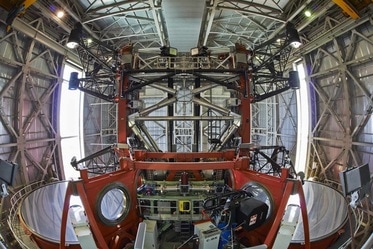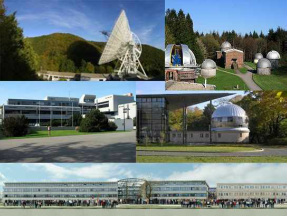About the LBTO
The Observatory
The Large Binocular Telescope Observatory (LBTO) is located in southeastern Arizona near Safford in the Pinaleno Mountains on Emerald Peak at an altitude of 3200m. This area is part of the Coronado National Forest. LBTO is headquartered on the Tucson campus of the University of Arizona.
The binocular design of the Large Binocular Telescope (LBT) has two identical 8.4m telescopes mounted side-by-side on a common altitude-azimuth mounting for a combined collecting area of a single 11.8m telescope. The entire telescope and enclosure are very compact by virtue of the fast focal ratio (F/1.14) of the primary mirrors.

The two primary mirrors are separated by 14.4m center-to-center and provide an interferometric baseline of 22.8m edge-to-edge. The binocular design, combined with integrated adaptive optics utilizing adaptive Gregorian secondary mirrors to compensate for atmospheric phase errors, provides a large effective aperture, high angular resolution, low thermal background, and exceptional sensitivity for the detection of faint objects.
The LBT is an international collaboration of the University of Arizona, Italy (INAF: Istituto Nazionale di Astrofisica), Germany (LBTB: LBT Beteiligungsgesellschaft), The Ohio State University, representing also the University of Minnesota, the University of Virginia, and the University of Notre Dame.
LBT Annual Report
The Observatory produces an Annual Report to help tell the LBT story. The intent is that this report will be released annually, providing an overview of accomplishments and ongoing work at LBT/LBTO, as well as updates to future plans.
Explore the LBTO
The Mission of the Observatory
“Aspiring to be the first of the ELTs and one of the leading 8-m class telescopes, LBTO must offer, state-of-the art instruments that efficiently and reliably deliver high-quality data to the users of the observatory, thus enabling excellent science at the forefront of astronomy”
LBTO has a dual mission: (1) to be the first Extremely Large Telescope (ELT), experimenting with new technologies that will be used for the ELT generation now currently under construction by enabling 23m-aperture class science and (2) to be one of the leading 8-m class telescopes.
This duality reflects the diversity of the LBTO partnership. Some partners have a strong interest in LBTO being a laboratory to develop new technologies, while others place more emphasis on LBTO to deliver high quality data with robust scientific productivity in the same vein as the other mature 8- to 10-m class telescopes. This mission also brings the observatory unusual challenges while placing it in a unique position among the existing large facilities
The scientific interests of the LBTO partnership span the full range of modern astrophysics, from exo-planets to the high-redshift universe. This broad spectrum of interests makes the LBTO a “community observatory” with observing programs drawing on the telescope’s unique capabilities: multiplex gain from its binocular nature and high-resolution from its interferometric modes. The partners agree that the observatory will play an important role, establishing its place among the leading current astronomical facilities of the world, and anticipating ELT-class science in the forthcoming decade that precedes the arrival of the GMT/TMT/E-ELT.
LBT’s intrinsic complexity, partnership arrangements, fiscal resources, and number of instruments and capabilities available to its users must be considered when comparing the LBTO to other large telescope facilities operated by consortia such as the VLTs, Keck, Gemini, Subaru, or GTC in terms of cost and efficiency. LBTO must keep its operation costs well-contained so that it can fulfill its mission at a cost commensurate with the services it provides.

University of Arizona - 25%
The University of Arizona - Tucson is the responsible party for maintaining astronomical observing facilities for the universities represented by the Arizona Board of Regents:

Germany LBTB - 25%
The LBT Beteiligungsgesellschaft coordinates the participation by five German institutes in the LBTO:

Italy INAF - 25%
Istituto Nazionale di Astrofisica is the responsible party for offering to the Italian astronomical community access to LBTO

The Ohio State University - OSU - 25%
The Ohio State University is coordinating the participation of four universities in the United States

